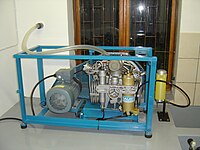
Photo from wikipedia
Abstract Theisen sludge is a complexly contaminated scrubber dust, which arised during the production of copper stone. Besides high contents of heavy metals, it also contains approximately 10% of a… Click to show full abstract
Abstract Theisen sludge is a complexly contaminated scrubber dust, which arised during the production of copper stone. Besides high contents of heavy metals, it also contains approximately 10% of a tar like organic fraction. Inorganic and organic components both represent an environmental risk and the assessment of potential remediation activities requires a detailed analysis of the contaminants. In this study, the organic part of the scrubber dust was analyzed by highly resolving gas chromatographic and mass spectrometric methods. Lower molecular weight compounds were analyzed by comprehensive gas chromatography (GC × GC-MS). A complex mixture of aliphatic and aromatic hydrocarbons was observed, which was predominantly composed of aromatic hydrocarbons with one to 4 rings with different number and length of alkylsubstituents. The most abundant heteroatomic compounds observed are benzo- and dibenzothiophenes and their alkylated homologues, but also phenols, carbazoles and acridines could be observed. Higher molecular weight compounds were analyzed by fourier transform ion cyclotron resonance mass spectrometry (FT-ICR-MS). Two different ionization methods, electrospray ionization (ESI) and graphite assisted laser desorption ionization (LDI), were used in positive and negative ionization mode. Compounds with masses up to 1450 u are observed. The results were evaluated based on the number of formulas in the molecular formula classes and their distribution in double bond equivalents versus carbon number plots (DBE-nC plots). The results from both ionization polarities show significant differences regarding the quality of observed molecular formulas and both ionization methods.
Journal Title: Microchemical Journal
Year Published: 2018
Link to full text (if available)
Share on Social Media: Sign Up to like & get
recommendations!